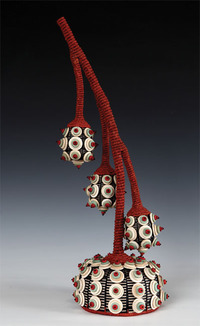New England Biennial 2012
Brattleboro Museum & Art Center • Brattleboro, VT • brattleboromuseum.org • Through March 1, 2013

JoAnne Russo, Flower and Buds, 2011, black ash splint,
waxed linen thread, paper cord, beads, 21 x 7 x 8″.
This is an exhibition of ideas, political and aesthetic, big and small. Ideas insinuate themselves, object by object, and BMAC’s chief curator Mara Williams uses the entire museum to great effect. According to guest juror Stephen Haller (of the Stephen Haller Gallery, New York), water arose as a strong secondary theme early in the selection of thirteen artists from a pool of more than 400 applicants.
Water ripples throughout the show as pure image in Roslyn Meyer’s exquisite archival pigment-print photographs and in Robert Steinem’s highly colored abstract paintings that manipulate surface. In Kathryn Lipke Vigesaa’s dramatic inter-media installation of huge horns, video, sound, and photographs, water connects us with the natural world. Global issues about the availability of drinking water are addressed in Christine Destrempes’s Stream of Conscience installation that Haller called “as mesmerizing as watching the continual rhythm of the ocean.”
Sculpture is a standout in this biennial. Michael Donovan’s work dominates
the entryway, both barring and inviting exploration. Red oak, steel cables, pulleys, and hardware suggest that his elaborate devices have working mechanics. They stand poised, in tension, at the ready. Beyond the sculptures, large windows showcase the Connecticut River surging behind the historic, former railroad station venue.
Elsewhere are JoAnne Russo’s one-of-a-kind sculptural objects: hand-dyed beads and waxed linen thread appoint texture to black ash wood. Her precision and craft creates a well-ordered harmony. Works by sculptors Denis Versweyveld and Greg Mencoff are among the show’s most successful pairings. Versweyveld’s plaster and rough wood objects, astride white plinths, elevate the importance of everyday things. His human-scale works converse with the “faces” of Mencoff’s work. The rich, creamy surfaces of Mencoff’s beautiful and complex wall sculptures beg to be touched, yet seem to deny permission. Versweyveld’s objects, like the teakettle, are familiar to our senses. Seeing them elevated, literally (on plinths), brings joy.
The odd artist out is Bénédicte Lassalle. Her masterfully composed color photographs are perfectly situated in a separate, almost private gallery. As a curatorial choice, The Coming Out Project seems out of place, like its subject matter. Either way, Lassalle’s photographic images and text are arresting and her humanity
invigorating.
—Meg Brazill
